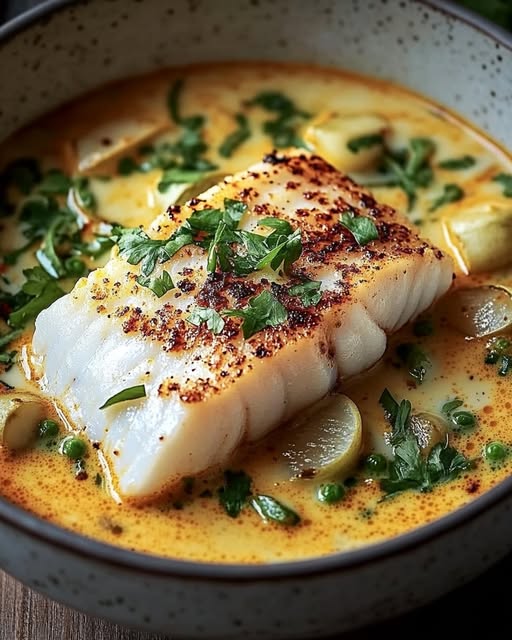Why Coconut Fish Curry is a Must-Try Dish
There’s something magical about the creamy, dreamy combination of coconut milk and delicate white fish. The first time I made this dish, I was hosting a dinner party for friends who claimed they weren’t big fans of fish. Well, let me tell you—plates were scraped clean, and I got three requests for the recipe before dessert even hit the table! Coconut Fish Curry is not just a dish; it’s an experience that brings people together. With its rich flavors, vibrant colors, and aromatic spices, this recipe has become my go-to for impressing guests and feeding my family.
The Story Behind Coconut Fish Curry
This dish draws inspiration from Southeast Asian cuisine, where coconut milk is a staple in curries. Traditionally, it’s a way to infuse seafood with bold, earthy spices while keeping it tender and moist. I fell in love with this dish during a trip to Thailand, where street vendors served it in banana leaf bowls. Back home, I decided to recreate it with ingredients I could find at my local grocery store. Over the years, I’ve tweaked the recipe to suit my taste buds, adding a touch more ginger for zing and fresh cilantro for brightness. It’s now a family favorite that feels both exotic and comforting.
Why You’ll Love This Recipe
If you’re looking for a dish that’s easy to make but feels like a restaurant-quality meal, this **Coconut Fish Curry** is your answer. The creamy sauce wraps around tender chunks of white fish, while the curry powder and ginger add warmth without overwhelming the delicate flavors. Plus, it’s ready in just 30 minutes! Whether you’re a beginner cook or a seasoned pro, this recipe will charm you with its simplicity and depth of flavor.
Perfect Occasions to Make Coconut Fish Curry
This dish shines on weeknights when you need something quick yet satisfying. It’s also perfect for dinner parties because it looks fancy but doesn’t require hours of prep. Pair it with steamed rice or crusty bread, and you’ve got a meal that feels celebratory. I’ve even served it as part of a holiday spread—it’s light enough to balance heavier dishes like mashed potatoes or stuffing.
What You’ll Need: Ingredients List
- 500 g of white fish fillets (such as cod or tilapia)
- 400 ml of coconut milk
- 1 onion, thinly sliced
- 2 garlic cloves, crushed
- 2 tomatoes, diced
- 2 teaspoons of curry powder
- 1 teaspoon of freshly grated ginger
- Fresh cilantro for garnish
- Salt and pepper to taste
- Olive oil for cooking
Ingredient Substitutions
No white fish? No problem! You can use shrimp, chicken, or even tofu for a vegetarian twist. If you don’t have fresh ginger, a pinch of ground ginger works fine. Swap out the cilantro for parsley if that’s what you have on hand. For those avoiding dairy, coconut milk is already a great option, but feel free to experiment with almond or cashew milk for a lighter sauce.
Step 1: Sauté the Aromatics
Start by heating a drizzle of olive oil in a large skillet over medium heat. Add the sliced onion and crushed garlic, letting them sizzle until golden and fragrant. This step is crucial—it builds the foundation of flavor for your curry. Watch closely to avoid burning; burnt onions can ruin the whole dish. Pro tip: Use a wooden spoon to scrape up any browned bits from the pan—they’re packed with flavor!
Step 2: Soften the Tomatoes
Once the onions are soft and caramelized, toss in the diced tomatoes. Stir occasionally, allowing them to break down and release their juices. After about 5 minutes, they should turn into a chunky sauce. The bright red color and tangy aroma will start filling your kitchen, making everyone curious about what’s cooking. Keep the heat steady to prevent scorching.
Step 3: Spice It Up
Sprinkle the curry powder and grated ginger over the softened vegetables. Stir everything together so the spices coat the mixture evenly. As they toast slightly in the pan, you’ll notice the scent intensifying—a warm, inviting fragrance that promises comfort. Don’t rush this step; toasting the spices enhances their flavor significantly.
Step 4: Pour in the Coconut Milk
Now comes the star ingredient: pour in the coconut milk. Stir gently to combine it with the spiced tomato base. As the sauce heats up, it will thicken slightly and take on a luscious creaminess. Imagine the contrast between the rich sauce and the flaky white fish you’re about to add—it’s almost too good to wait!
Step 5: Cook the Fish
Cut the fish into bite-sized pieces and nestle them into the simmering sauce. Make sure each piece is partially submerged so it cooks evenly. Let it simmer for 10-15 minutes, flipping the fish halfway through. Be gentle—you don’t want to break the delicate fillets. When done, the fish should be opaque and fork-tender, practically melting in your mouth.
Step 6: Season and Garnish
Taste the curry and adjust the seasoning with salt and pepper. Sprinkle chopped cilantro on top for a pop of freshness. Not only does it look beautiful, but the herbaceous notes tie all the flavors together. Serve hot, and watch as everyone digs in with enthusiasm.
Chef’s Tip
For an extra layer of flavor, squeeze a bit of lime juice over the finished dish. The acidity brightens the richness of the coconut milk and balances the spices beautifully.
Timing Breakdown
- Preparation Time: 10 minutes
- Cooking Time: 20 minutes
- Total Time: 30 minutes
Chef’s Secret
Use full-fat coconut milk for the creamiest texture. Light versions won’t give you the same luxurious result.
Fun Fact About Coconut Fish Curry
Did you know that coconut milk has been used in tropical cuisines for centuries? Its natural sweetness and creaminess make it a versatile ingredient, capable of transforming simple ingredients into gourmet meals.
Necessary Equipment
- Large skillet or frying pan
- Wooden spoon or spatula
- Sharp knife for chopping
- Cutting board
- Measuring spoons
How to Store Leftovers
To store leftover Coconut Fish Curry, transfer it to an airtight container and refrigerate within two hours of cooking. It will stay fresh for up to three days. Reheat gently on the stovetop over low heat to avoid overcooking the fish. Avoid freezing, as the texture of the fish may change upon thawing.
If you plan to freeze the sauce alone (without fish), it can last up to three months. Thaw overnight in the fridge before reheating and adding fresh fish.
When serving leftovers, consider stirring in a splash of coconut milk to revive the sauce’s creaminess.
Tips and Advice
Always pat the fish dry before adding it to the curry. Excess moisture can dilute the sauce. Choose firm white fish varieties like cod or halibut for best results. For a spicier kick, add a pinch of red chili flakes along with the curry powder.
Presentation Tips
- Garnish generously with fresh cilantro or parsley for a pop of green.
- Serve in shallow bowls with a wedge of lime on the side.
- Pair with steamed basmati rice or naan bread for a complete meal.
Healthier Alternatives
Here are six ways to tweak this recipe for different dietary needs:
- Low-Carb Option: Skip the rice and serve the curry over cauliflower rice.
- Vegan Version: Replace fish with chickpeas or paneer cheese.
- Gluten-Free: Ensure your curry powder is certified gluten-free.
- Lower Fat: Use light coconut milk instead of full-fat.
- Protein Boost: Add spinach or kale for extra nutrients.
- Spice Level Control: Adjust the amount of curry powder based on preference.
Mistake 1: Overcooking the Fish
Overcooked fish becomes tough and rubbery, ruining the texture of your curry. To avoid this, keep an eye on the fish as it simmers. Once it turns opaque and flakes easily, it’s done. Pro tip: Remove the pan from heat slightly earlier than you think necessary—the residual heat will finish the job.
Mistake 2: Skipping the Spice Toasting Step
Some cooks rush through toasting the spices, but this step is vital for unlocking their full potential. Without it, your curry might taste flat. Take your time and let the spices sizzle briefly before adding liquids.
Mistake 3: Using Low-Quality Coconut Milk
Cheap coconut milk often contains fillers that affect the flavor and consistency. Invest in a high-quality brand with minimal additives for the best results.
FAQs About Coconut Fish Curry
Can I use frozen fish?
Yes, but thaw it completely and pat it dry before using. Frozen fish releases excess water, which can thin out the sauce.
What type of white fish works best?
Firm-textured fish like cod, tilapia, or halibut hold up well in curries. Avoid delicate varieties like sole, which may fall apart.
Is this dish spicy?
Not inherently, but you can adjust the spice level by adding chili flakes or reducing the curry powder.
Can I make this ahead of time?
Yes, prepare the sauce in advance and store it in the fridge. Add fresh fish just before serving to ensure optimal texture.
Does this recipe work with other proteins?
Absolutely! Try it with shrimp, chicken, or tofu for a delicious variation.
How do I reheat leftovers?
Reheat gently on the stovetop over low heat to avoid breaking down the fish further.
Can I freeze this dish?
Freezing isn’t ideal due to the fish’s delicate texture, but the sauce alone freezes well for up to three months.
What sides pair well with this curry?
Basmati rice, quinoa, or crusty bread are excellent choices. A side salad adds freshness.
Why is my sauce too thin?
If the sauce is too runny, simmer it uncovered for a few extra minutes to reduce and thicken.
Can I use canned tomatoes?
Yes, canned diced tomatoes work perfectly if fresh ones aren’t available.
Final Thoughts
Coconut Fish Curry is a dish that proves simplicity can still be spectacular. With its creamy sauce, fragrant spices, and tender fish, it’s a recipe that’s bound to become a household favorite. Whether you’re cooking for yourself or entertaining guests, this curry delivers on flavor and ease. So grab your skillet, gather your ingredients, and get ready to create a meal that’s as comforting as it is impressive. Happy cooking!

Coconut Fish Curry
Ingredients
Equipment
Method
- Heat a drizzle of olive oil in a large skillet over medium heat. Add the sliced onion and crushed garlic; sauté until golden and fragrant.
- Add the diced tomatoes and stir occasionally, allowing them to break down and release their juices for about 5 minutes to create a chunky sauce.
- Sprinkle the curry powder and grated ginger over the vegetables and stir to coat evenly.
- Pour in the coconut milk and stir gently to combine, allowing the sauce to heat up and thicken slightly.
- Cut the fish into bite-sized pieces and nestle them into the simmering sauce. Let it cook for 10-15 minutes, flipping the fish halfway.
- Taste the curry and adjust seasoning with salt and pepper. Sprinkle chopped cilantro on top for garnish. Serve hot.
